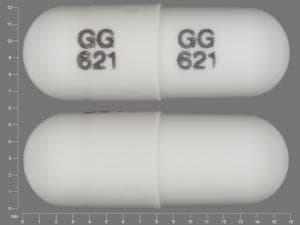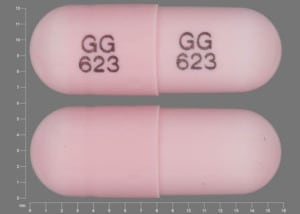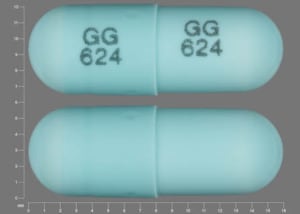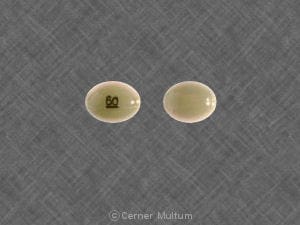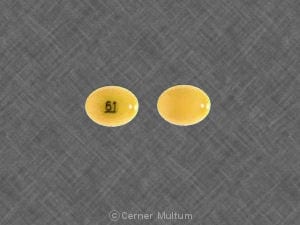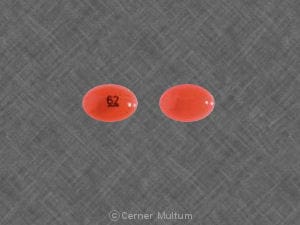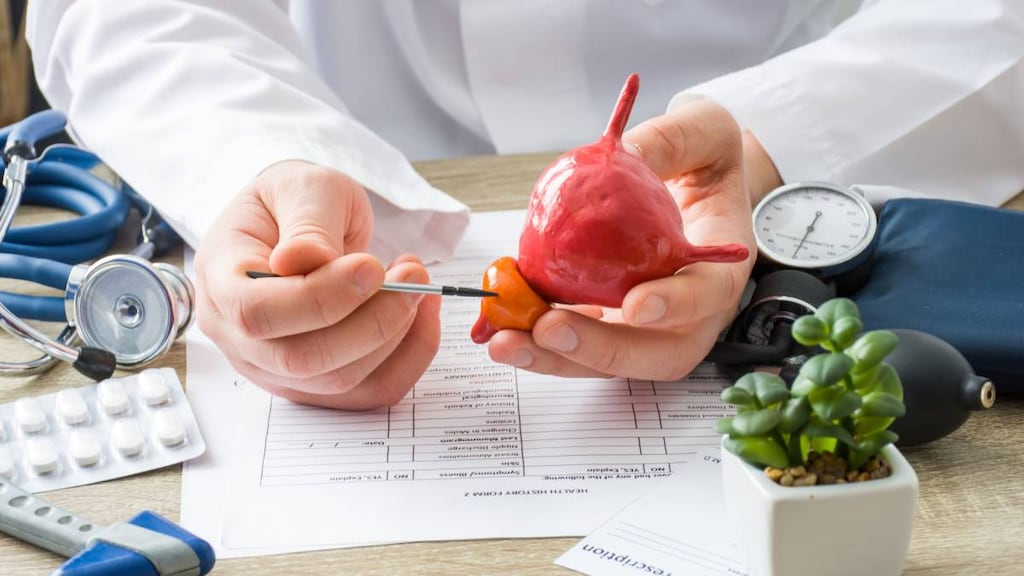Dosage Forms
Excipient information presented when available (limited, particularly for generics); consult specific product labeling.
Capsule, Oral:
Generic: 1 mg, 2 mg, 5 mg, 10 mg
Pharmacology
Mechanism of Action
Alpha1-specific blocking agent with minimal alpha2 effects; this allows peripheral postsynaptic blockade, with the resultant decrease in arterial tone, while preserving the negative feedback loop which is mediated by the peripheral presynaptic alpha2-receptors; terazosin relaxes the smooth muscle of the bladder neck, thus reducing bladder outlet obstruction
Pharmacokinetics/Pharmacodynamics
Absorption
Rapid and complete
Metabolism
Hepatic; minimal first-pass
Excretion
Feces (~60%, ~20% as unchanged drug); urine (~40%, ~10% as unchanged drug)
Onset of Action
Antihypertensive effect: 15 minutes; Peak effect: Antihypertensive effect: 2 to 3 hours
Time to Peak
Plasma: ~1 hour; delayed ~40 minutes with food
Duration of Action
Antihypertensive effect: 24 hours
Half-Life Elimination
~12 hours
Protein Binding
90% to 94%
Use in Specific Populations
Special Populations: Elderly
Plasma clearance was decreased by 31.7% and half-life was 14 hours in patients ≥70 years.
Use: Labeled Indications
Benign prostatic hyperplasia: Treatment of symptomatic benign prostatic hyperplasia (BPH)
Hypertension: Management of hypertension. Note: Alpha blockers are not recommended as first line therapy (ACC/AHA [Whelton 2017]).
Use: Off Label
Ureteral calculi expulsionbyes
Use of alpha-1 adrenergic blockers, including terazosin, for treating ureteral calculi is supported by data from a meta-analysis as well as numerous controlled trials. Tamsulosin has the most data, but terazosin has also demonstrated efficacy in facilitating expulsion of ureteral stones (<10 mm) as medical therapy alone or as an adjunct to shock wave lithotripsy and uteroscopy. Some trials indicate a class effect of alpha-1 adrenergic blockers, with terazosin reported to be equally effective as tamsulosin, doxazosin, and alfuzosin Campshroer 2018, Gurbuz 2011, Wang 2009.
American Urological Association/Endourological Society guidelines and European Association of Urology guidelines recommend use of alpha-1 blockers, including terazosin, for treating ureteral calculi
Contraindications
Hypersensitivity to terazosin or any component of the formulation
Dosage and Administration
Dosing: Adult
Note: If terazosin is discontinued for several days or longer, consider beginning with initial dose and retitrate as needed.
Benign prostatic hyperplasia: Oral: Initial: 1 mg at bedtime; thereafter, titrate upwards, if needed, over several weeks, balancing therapeutic benefit with terazosin-induced postural hypotension; most patients require 10 mg once daily; if no response after 4 to 6 weeks of 10 mg/day, may increase to 20 mg/day (maximum: 20 mg/day).
Hypertension (alternative agent): Oral: Initial: 1 mg once daily; titrate as needed based on patient response up to a dose of 20 mg daily in 1 or 2 divided doses (ACC/AHA [Whelton 2017]). Note: Administration at bedtime may help limit orthostasis.
Ureteral calculi expulsion (off-label use): Oral: 2 to 5 mg at bedtime for up to 2 weeks or until stone expulsion; may be used as adjunctive therapy to shock wave lithotripsy (Gurbuz 2011; Wang 2009).
Dosing: Geriatric
Avoid use for hypertension treatment (Beers Criteria [AGS 2019]). Refer to adult dosing for other indications.
Dosing: Pediatric
Hypertension: Children and Adolescents: Limited data available: Oral: Initial: 1 mg once daily typically administered at bedtime; slowly increase dose to achieve desired blood pressure as tolerated; maximum daily dose: 20 mg/day (NHBPEP 2004; NHLBI 2011). Note: If drug is discontinued for greater than several days, consider beginning with initial dose and retitrate as needed.
Administration
Oral: Administer at the same time each day.
Storage
Store at 20°C to 25°C (68°F to 77°F); protect from light and moisture.
Terazosin Images
Drug Interactions
Alpha-/Beta-Agonists: Alpha1-Blockers may diminish the vasoconstricting effect of Alpha-/Beta-Agonists. Similarly, Alpha-/Beta-Agonists may antagonize Alpha1-Blocker vasodilation. Monitor therapy
Alpha1-Agonists: Alpha1-Blockers may diminish the vasoconstricting effect of Alpha1-Agonists. Similarly, Alpha1-Agonists may antagonize Alpha1-Blocker vasodilation. Monitor therapy
Alpha1-Blockers: May enhance the antihypertensive effect of other Alpha1-Blockers. Avoid combination
Amifostine: Blood Pressure Lowering Agents may enhance the hypotensive effect of Amifostine. Management: When amifostine is used at chemotherapy doses, blood pressure lowering medications should be withheld for 24 hours prior to amifostine administration. If blood pressure lowering therapy cannot be withheld, amifostine should not be administered. Consider therapy modification
Amphetamines: May diminish the antihypertensive effect of Antihypertensive Agents. Monitor therapy
Antipsychotic Agents (Second Generation [Atypical]): Blood Pressure Lowering Agents may enhance the hypotensive effect of Antipsychotic Agents (Second Generation [Atypical]). Monitor therapy
Barbiturates: May enhance the hypotensive effect of Blood Pressure Lowering Agents. Monitor therapy
Benperidol: May enhance the hypotensive effect of Blood Pressure Lowering Agents. Monitor therapy
Beta-Blockers: May enhance the orthostatic hypotensive effect of Alpha1-Blockers. The risk associated with ophthalmic products is probably less than systemic products. Exceptions: Levobunolol; Metipranolol. Monitor therapy
Brigatinib: May diminish the antihypertensive effect of Antihypertensive Agents. Brigatinib may enhance the bradycardic effect of Antihypertensive Agents. Monitor therapy
Brimonidine (Topical): May enhance the hypotensive effect of Blood Pressure Lowering Agents. Monitor therapy
Bromperidol: Blood Pressure Lowering Agents may enhance the hypotensive effect of Bromperidol. Bromperidol may diminish the hypotensive effect of Blood Pressure Lowering Agents. Avoid combination
Calcium Channel Blockers: Alpha1-Blockers may enhance the hypotensive effect of Calcium Channel Blockers. Monitor therapy
Dapoxetine: May enhance the orthostatic hypotensive effect of Alpha1-Blockers. Monitor therapy
Dexmethylphenidate: May diminish the therapeutic effect of Antihypertensive Agents. Monitor therapy
Diazoxide: May enhance the hypotensive effect of Blood Pressure Lowering Agents. Monitor therapy
DULoxetine: Blood Pressure Lowering Agents may enhance the hypotensive effect of DULoxetine. Monitor therapy
Herbs (Hypertensive Properties): May diminish the antihypertensive effect of Antihypertensive Agents. Monitor therapy
Herbs (Hypotensive Properties): May enhance the hypotensive effect of Blood Pressure Lowering Agents. Monitor therapy
Hypotension-Associated Agents: Blood Pressure Lowering Agents may enhance the hypotensive effect of Hypotension-Associated Agents. Monitor therapy
Levodopa-Containing Products: Blood Pressure Lowering Agents may enhance the hypotensive effect of Levodopa-Containing Products. Monitor therapy
Lormetazepam: May enhance the hypotensive effect of Blood Pressure Lowering Agents. Monitor therapy
Methylphenidate: May diminish the antihypertensive effect of Antihypertensive Agents. Monitor therapy
Molsidomine: May enhance the hypotensive effect of Blood Pressure Lowering Agents. Monitor therapy
Nicorandil: May enhance the hypotensive effect of Blood Pressure Lowering Agents. Monitor therapy
Nitroprusside: Blood Pressure Lowering Agents may enhance the hypotensive effect of Nitroprusside. Monitor therapy
Obinutuzumab: May enhance the hypotensive effect of Blood Pressure Lowering Agents. Management: Consider temporarily withholding blood pressure lowering medications beginning 12 hours prior to obinutuzumab infusion and continuing until 1 hour after the end of the infusion. Consider therapy modification
Pentoxifylline: May enhance the hypotensive effect of Blood Pressure Lowering Agents. Monitor therapy
Pholcodine: Blood Pressure Lowering Agents may enhance the hypotensive effect of Pholcodine. Monitor therapy
Phosphodiesterase 5 Inhibitors: May enhance the hypotensive effect of Alpha1-Blockers (Nonselective). Management: Ensure patient is stable on one agent prior to initiating the other, and always initiate combination using the lowest possible dose of the drug being added. When tadalafil is used for treatment of BPH, concurrent alpha 1-blockers are not recommended. Consider therapy modification
Prostacyclin Analogues: May enhance the hypotensive effect of Blood Pressure Lowering Agents. Monitor therapy
Quinagolide: May enhance the hypotensive effect of Blood Pressure Lowering Agents. Monitor therapy
Rilmenidine: Alpha1-Blockers may enhance the hypotensive effect of Rilmenidine. Monitor therapy
Yohimbine: May diminish the antihypertensive effect of Antihypertensive Agents. Monitor therapy
Adverse Reactions
>10%:
Central nervous system: Dizziness (9% to 19%), myasthenia (7% to 11%)
1% to 10%:
Cardiovascular: Peripheral edema (1% to 6%), orthostatic hypotension (1% to 4%), palpitations (≤4%), tachycardia (≤2%), syncope (≤1%)
Central nervous system: Drowsiness (4% to 5%), paresthesia (≤3%), vertigo (1%)
Endocrine & metabolic: Decreased libido (≤1%), weight gain (≤1%)
Gastrointestinal: Nausea (2% to 4%)
Genitourinary: Impotence (≤2%)
Neuromuscular & skeletal: Limb pain (≤4%), back pain (≤2%)
Ophthalmic: Blurred vision (≤2%)
Respiratory: Nasal congestion (2% to 6%), dyspnea (2% to 3%), sinusitis (≤3%)
<1%, postmarketing, and/or case reports: Abdominal pain, anaphylaxis, anxiety, arthralgia, arthritis, arthropathy, atrial fibrillation, bronchitis, cardiac arrhythmia, chest pain, conjunctivitis, constipation, cough, diaphoresis, diarrhea, dyspepsia, epistaxis, facial edema, fever, flatulence, flu-like symptoms, gout, hypersensitivity reaction, insomnia, intraoperative floppy iris syndrome (IFIS), myalgia, neck pain, pharyngitis, polyuria, priapism, pruritus, rhinitis, shoulder pain, skin rash, thrombocytopenia, tinnitus, urinary incontinence, urinary tract infection, vasodilation, visual disturbance, vomiting, xerostomia
Warnings/Precautions
Concerns related to adverse effects:
- CNS depression: May cause CNS depression, which may impair physical or mental abilities; patients must be cautioned about performing tasks that require mental alertness (eg, operating machinery or driving).
- Floppy iris syndrome: Intraoperative floppy iris syndrome has been observed in cataract surgery patients who were on or were previously treated with alpha1-blockers; there appears to be no benefit in discontinuing alpha-blocker therapy prior to surgery. May require modifications to surgical technique.
- Orthostatic hypotension/syncope: May cause significant orthostatic hypotension and syncope, especially with first dose or first few days of therapy; anticipate a similar effect if therapy is interrupted for a few days, if dosage is rapidly increased, or if another antihypertensive drug (particularly vasodilators) or a PDE-5 inhibitor is introduced.
- Priapism: Priapism has been associated with use (rarely); seek immediate medical assistance for erections lasting longer than 4 hours.
Disease-related concerns:
- Heart failure: In a scientific statement from the American Heart Association, terazosin has been determined to be an agent that may exacerbate underlying myocardial dysfunction (magnitude: moderate) (AHA [Page 2016]).
Concurrent drug therapy issues:
- Drug-drug interactions: Potentially significant interactions may exist, requiring dose or frequency adjustment, additional monitoring, and/or selection of alternative therapy. Consult drug interactions database for more detailed information.
Other warning/precautions:
- Appropriate use: BPH: Rule out prostatic carcinoma before beginning therapy (many symptoms of BPH and prostate cancer are similar).
Monitoring Parameters
Standing and sitting/supine blood pressure, especially following the initial dose at 2-4 hours following the dose and thereafter at the trough point to ensure adequate control throughout the dosing interval; urinary symptoms
Hypertension: The 2017 Guideline for the Prevention, Detection, Evaluation, and Management of High Blood Pressure in Adults (ACC/AHA [Whelton 2017]):
Confirmed hypertension and known CVD or 10-year ASCVD risk ≥10%: Target blood pressure <130/80 mm Hg is recommended
Confirmed hypertension without markers of increased ASCVD risk: Target blood pressure <130/80 mm Hg may be reasonable
Pregnancy
Pregnancy Risk Factor
C
Pregnancy Considerations
Adverse events have been observed in some animal reproduction studies.
Chronic maternal hypertension may increase the risk of birth defects, low birth weight, preterm delivery, stillbirth, and neonatal death. Actual fetal/neonatal risks may be related to duration and severity of maternal hypertension. Untreated hypertension may also increase the risks of adverse maternal outcomes, including gestational diabetes, myocardial infarction, preeclampsia, stroke, and delivery complications (ACOG 203 2019).
Agents other than terazosin are more commonly used to treat hypertension in pregnancy (ACOG 203 2019; ESC [Regitz-Zagrosek 2018]). Females with preexisting hypertension may continue their medication during pregnancy unless contraindications exist (ESC [Regitz-Zagrosek 2018]).
Patient Education
What is this drug used for?
- It is used to treat high blood pressure.
- In men, it is used to treat the signs of an enlarged prostate.
- It may be given to you for other reasons. Talk with the doctor.
Frequently reported side effects of this drug
- Fatigue
- Runny nose
- Nausea
- Loss of strength and energy
- Headache
Other side effects of this drug: Talk with your doctor right away if you have any of these signs of:
- Severe dizziness
- Passing out
- Vision changes
- Fast heartbeat
- Abnormal heartbeat
- Swelling of arms or legs
- Erection that lasts more than 4 hours
- Signs of a significant reaction like wheezing; chest tightness; fever; itching; bad cough; blue skin color; seizures; or swelling of face, lips, tongue, or throat.
Note: This is not a comprehensive list of all side effects. Talk to your doctor if you have questions.
Consumer Information Use and Disclaimer: This information should not be used to decide whether or not to take this medicine or any other medicine. Only the healthcare provider has the knowledge and training to decide which medicines are right for a specific patient. This information does not endorse any medicine as safe, effective, or approved for treating any patient or health condition. This is only a brief summary of general information about this medicine. It does NOT include all information about the possible uses, directions, warnings, precautions, interactions, adverse effects, or risks that may apply to this medicine. This information is not specific medical advice and does not replace information you receive from the healthcare provider. You must talk with the healthcare provider for complete information about the risks and benefits of using this medicine.
